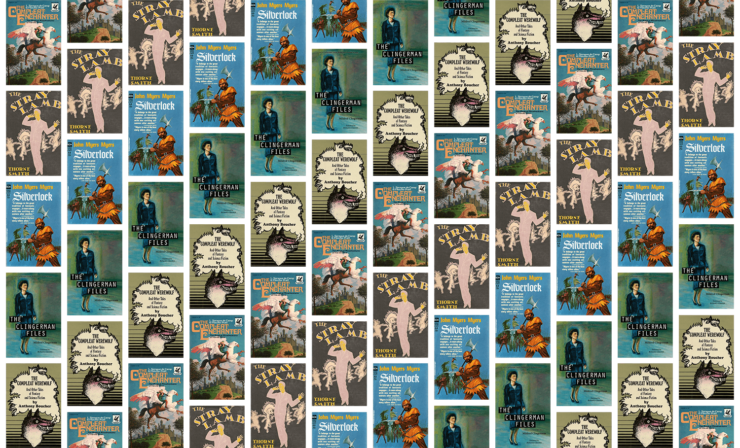Younger people, on being exposed to the events of the world prior to 1980 by means of the daguerreotypes so popular in those long-ago days, may be misled by the conventions surrounding such portraits into thinking people were a lot more serious than they actually were. When recording an image is a matter of many minutes, one is inclined to treat the occasion as a formal one.
However, archaeological evidence shows that the hominins of that era were indistinguishable from anatomically modern humans. Despite being hobbled by rudimentary technology, they were persons in most senses of the word, capable of virtually the full range of cognitive processes true humans now display. This includes humour. If you think that there might have been no comedic fantasy before 1980, you might want to consider these five vintage American fantasies.
The Stray Lamb by Thorne Smith (1929)
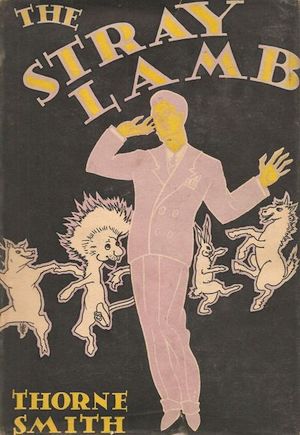
Mr. T. Lawrence Lamb enjoys a comfortable middle-class life, save for a few minor defects: a debilitating self-loathing, a job he grudgingly tolerates, a commute he loathes, and a wife whose affections are for good reason focused far from Lamb. But he can enjoy whatever is left over until he retires or dies of ennui.
A seeming chance encounter upends his perfectly conventional life. Lamb is unaccountably afflicted with a tendency to transform into animals (of one kind or another) at inconvenient moments. This leads to scandal after scandal. It also leads to a dalliance with the attractive Sandra. It’s enough to drive a man to drink. Not that Lamb (or anyone else in this novel) needed much encouragement to drink.
The book is funny, in the way that all Thorne Smith novels are funny. Not as funny now, after a hundred years of social change, but still amusing.
In defense of Mrs. Lamb: while the novel reads as if it had been written by a man trapped in an unhappy existence, a man relieving his despair with unlikely fantasies, it’s pretty clear that marriage to Mr. Lamb wouldn’t be all that much fun for Mrs. Lamb. Blowing up the marriage and forcing Lamb to reinvent himself was probably best of all concerned.
Silverlock by John Myers Myers (1949)
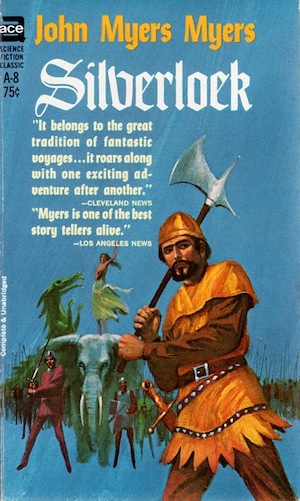
A. Clarence Shandon (M.B.A., Wisconsin) prides himself in being a practical man who disdains the childish distractions of myth and literature. Thus, Shandon did not think twice about boarding a ship named Naglfar. Surviving the shipwreck that follows, Shandon’s only thought on washing ashore is survival, not curiosity about the Commonwealth of Letters in which he finds himself.
Befriended and guided by Commonwealth native Golias, Shandon—now renamed Silverlock—wanders the Commonwealth, encountering figures whom the well-read will easily recognize as figures of myth and fiction. Shandon, being the proudly blinkered man that he is, remains oblivious. However, even a man such as Shandon cannot resist being transformed by the Commonwealth of Letters.
The author’s assumption here is that readers will be far more conversant than is Shandon with the tales referenced in Shandon’s journey. Poor Shandon’s failure to understand the significance of his encounters serves a higher purpose: amusing John Myers Myers’ audience as they watch Shandon carefully step on yet another rake, having learned nothing from the previous rake.
“The Roaring Trumpet” by L. Sprague de Camp and Fletcher Pratt (1940)
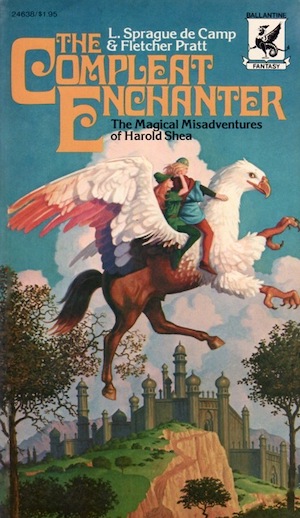
Suspecting that his patients’ mental issues are caused by resonance with other universes, psychologist Reed Chalmers devises a cunning system of symbolic logic that could, if properly applied, transport a person from one universe to another. Not being foolhardy, he hesitates to put his creation to a practical test. Death in another universe is still death.
Enter Harold Shea, a man bored with caution. Dissatisfied with mundane life, he sets out for a universe of Irish mythology. He arrives in a land of Norse myth, specifically one on the brink of Ragnarok. Still, a modern man like Shea should have no trouble impressing the natives…if the world he was in obeyed the laws of our universe rather than those of Norse legend. Shea’s prospects seem quite dismal.
If you are going to pioneer a groundbreaking and for all you know extremely dangerous new science, try very hard to determine first whether you are the protagonist in an ongoing comic fantasy series or a grim example of the consequences of hubris. The easiest way to tell the two apart? If your story is in Unknown, you may be battered and humiliated but you will probably survive. If alternatively, you discover you are in Weird Tales, make sure your affairs are in order.
“The Compleat Werewolf,” Anthony Boucher (1942)
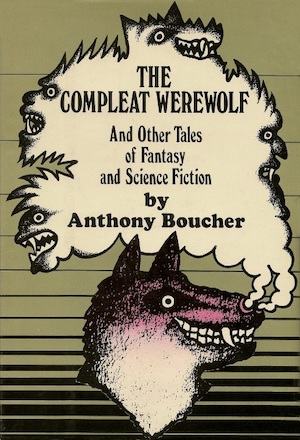
Heartbroken to discover that coed-turned-moving-picture-star Gloria Garton has better romantic options than her former teacher, Professor Wolfe, Wolfe proceeds to drown his sorrows in a seedy bar. There, self-declared magician Ozymandias reveals to Wolfe a secret that Wolfe’s name probably should have suggested: Wolfe is a werewolf; he can unlock his nature by means of a secret technique the Ozymandias will teach him. Once a boring old academic, now a dangerous wolf!
Embracing his newfound powers with more enthusiasm than prudence, Wolfe proceeds to discover all the ways in which lycanthropy can change a man’s life. For example, transitioning from a socially acceptable unclothed wolf into a less socially acceptable unclothed professor in a classroom is an excellent way to find oneself available for new employment opportunities. For another, a man turned wolf in the right place at the right time could confound a Nazi plot… if he doesn’t get himself shot first.
One of the many little catches Wolfe discovers too late is that while changing from wolf to human requires only someone utter the word “Absarka!”, wolves cannot talk. However, it could have been much worse; Ozymandias mentions in passing the tale of a man who discovered he could transform into a full-sized diplodocus. Unfortunately, he was standing in a decidedly smaller-than-diplodocus-sized house at the time.
“The Little Witch of Elm Street” by Mildred Clingerman (1956)
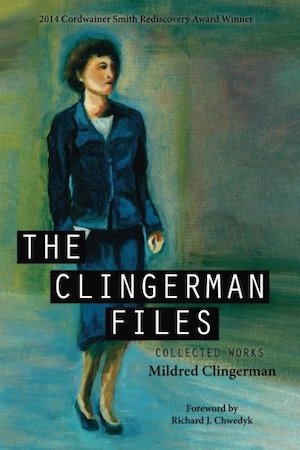
Nina appears to be an adorable little four-year-old girl, a child over whom besotted adults might coo. She is, however, the neighborhood menace, a child towards whom adults might direct muttered curses as they stanch bleeding calves left in the wake of the girl’s latest tricycle outrage. To quote one of Nina’s unfortunate neighbors, Nina is “seven kinds of unmitigated hell.”
Twelve-year-old Garnet Bayard has her own theory about Nina. Garnet does not think Nina is seven kinds of unmitigated hell. Garnet believes that Nina is a victim of demonic possession. Someone will have to rid Nina of her devil. Garnet is determined to be that person. Good thing Garnet is a witch.
A common trope in what one might call “late baby boom speculative fiction” is a terrifying child against whose powers potential adults cannot prevail. In SF, the child might be a prodigy, psionic, or a mutant. Nina is the fantasy analog, a possessed little girl. I don’t know what in particular would make children such figures of dread fascination in the 1950s.
***
Old-time Americans being as capable of humour as modern humans and equipped with the rudimentary written language needed to record their tales, there are many of comedic fantasy tales like the ones that I have just noted. Perhaps you have dabbled in the detritus of the distant past and have your own favourite comedic tales, tales that I have inexplicably overlooked. If so, feel free to mention them in comments, which are, as ever, below.
In the words of fanfiction author Musty181, four-time Hugo finalist, prolific book reviewer, and perennial Darwin Award nominee James Davis Nicoll “looks like a default mii with glasses.” His work has appeared in Interzone, Publishers Weekly and Romantic Times as well as on his own websites, James Nicoll Reviews (where he is assisted by editor Karen Lofstrom and web person Adrienne L. Travis) and the 2021 and 2022 Aurora Award finalist Young People Read Old SFF (where he is assisted by web person Adrienne L. Travis). His Patreon can be found here.










